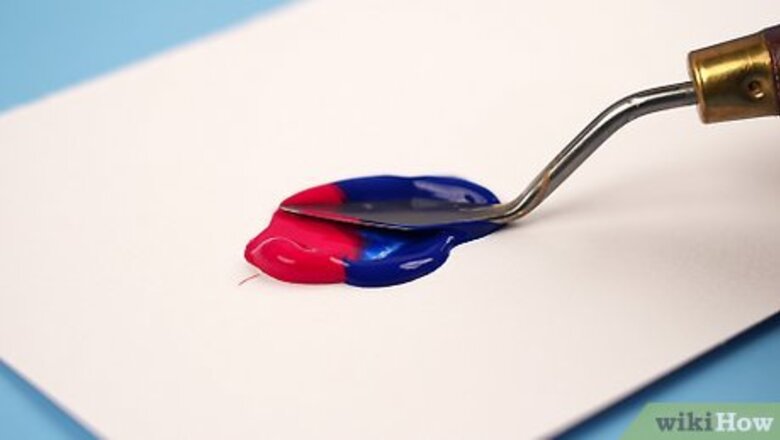
views
- Mix equal parts of a cool-toned red, like permanent rose or quinacridone magenta, and a warm-toned blue, like ultramarine blue, to make a true purple.
- Add more ultramarine blue in small increments to create a darker and deeper purple. Or, mix in more permanent rose for a warm, rich violet purple.
- Mix in small amounts of black to make darker purples like eggplant. To make lighter purples like lavender, mix small amounts of purple paint with white paint.
Choosing Red and Blue Paint

Combine a warm-toned blue with a cool-toned red to get purple. While mixing red with blue makes purple, the undertones of the paint determine the purple you get. If you look at a color wheel, each color has either a cool or warm undertone. When you look at where purple falls on the wheel, it’s in between a cool-toned red, or a red with blue undertones, and a warm-toned blue, or a blue with red undertones. So, a true purple is made by mixing equal parts of a warm blue with a cool red. Ultramarine blue and phthalo blue, specifically the red shade, are warm-toned blues. Alizarin crimson, quinacridone magenta, and permanent rose are cool-toned reds. Cobalt blue is more of a true neutral, but it also makes a true purple. While the exact paint names might differ, using a warm blue and a cool red makes a beautiful purple regardless if you’re using acrylic, oil, watercolor, or tempera paint.
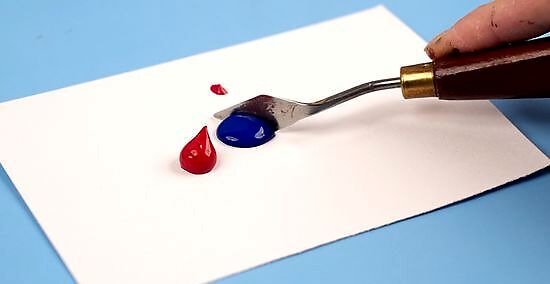
Choose red and blue paints that don’t contain a yellow color bias. Most paints have a color bias, or contain hints of the color on either side of them on the color wheel. Red paints either have a yellow bias, so they appear more orange, or a blue bias, where they look more purple. Similarly, blue can have hints of yellow that make it look greener, or a red bias that gives it a purple-y look. When you mix reds and blues that contain yellow, the resulting purple tends to look murky or brownish. As you might have noticed, the warm-toned blues and cool-toned reds that make a true purple also don’t contain a yellow bias. In color theory, mixing the 3 primary colors of red, blue, and yellow makes brown. That’s why you get a purple-y brown shade when you mix a red and blue with a yellow bias.
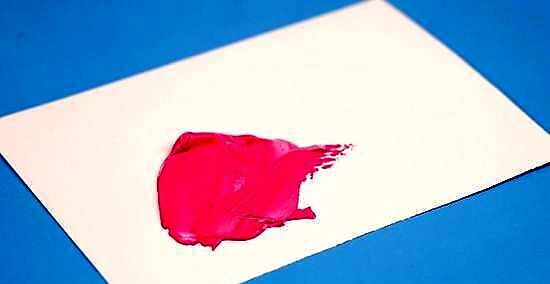
Test your red and blue paint for color bias by mixing them with white. When you mix red paint without a yellow color bias with white paint, it looks pink. If your red has a yellow bias, the mixture looks peach. Blue paint that doesn’t have a yellow bias changes to sky blue when you mix it with white. But, if you mix a blue with a yellow bias, the resulting color looks blue-green. When you test your paint colors, you don’t need to use much paint at all. Just add a small dollop of each color to view the results. If you’re not sure whether a red or blue paint contains yellow, look at the label on the paint tube. Red paints that list a yellow or orange pigment and blue paints that list a yellow or green pigment have a yellow color bias.Tip: Wipe off your paintbrush or palette knife with a paper towel in between mixing colors so you don’t contaminate your blue with red or vice versa.
Mixing a True Purple
Mix equal amounts of permanent rose and ultramarine blue. These 2 shades of paint mix together really well to make what art experts call the “perfect purple.” When you combine permanent rose and ultramarine blue, you get a medium shade that’s similar to what you find in a pre-mixed tube of purple. Just get out your paint mixing palette or a plate and add a dollop of red and blue paint. Then, combine them together with a palette knife or a paintbrush. Importantly, permanent rose and ultramarine blue don't have any yellow in them.

Use quinacridone magenta or alizarin crimson instead of permanent rose. Quinacridone magenta and alizarin crimson give you slightly different variations of a true purple. Adding equal parts of quinacridone magenta and ultramarine blue gives you a gorgeous true violet that’s slightly more muted than the permanent rose mixture. If you want a deeper true purple that’s more on the gray side, mix the same amounts of alizarin crimson with ultramarine blue.
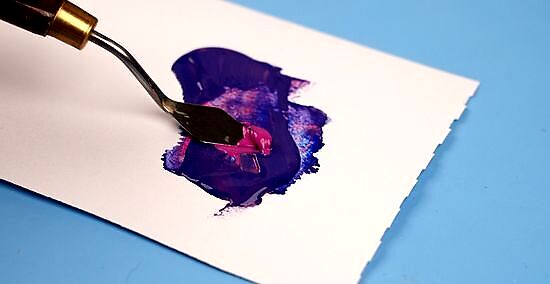
Mix small amounts of paint at a time to make your true purple. If you’re not happy with your purple after mixing equal amounts of red and blue, just cover the tip of your palette knife or paintbrush with either color. Mix the paint together, then test the color on a sheet of paper before adding another small dab of paint. It’s easy to add more paint to adjust the purple, but it’s more difficult to get a shade back to its original color if you add too much of something. Adding more blue makes your purple cooler and darker if it’s too light, while adding more red does the opposite. Swirl your brush in a cup of water, or wipe off your palette knife with a paper towel, before you grab more red or blue paint. This keeps you from muddying up your colors.
Making Dark and Muted Purples
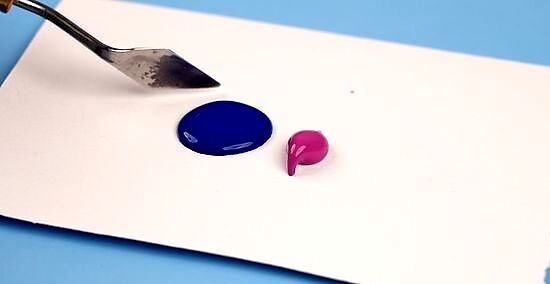
Add more ultramarine blue than permanent rose for a deeper purple. Make this purple if you want a darker, cooler, richer, color for your paintings or crafts. Just add a small dollop of ultramarine blue to the purple paint you mixed. Then, test out the new color on a scrap piece of paper. Gradually build up to the deep purple you want by continuing to add blue in small increments.
Mix permanent rose with cerulean blue to make a dark gray-purple. Cerulean blue has a slight yellow bias, that when added to the permanent rose, produces a dark shade of purple with gray undertones. Just mix equal parts of cerulean blue with permanent rose on your palette to add a moody, more diluted purple to your painting. If you want an even darker shade, add more cerulean blue.
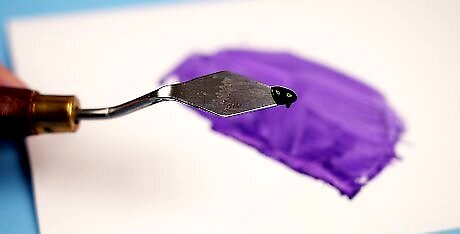
Use small amounts of black paint to make darker shades of purple. To make eggplant, wine, or raisin purple, just add the tiniest pin-prick of black to your true purple mixture. Use your paintbrush or palette knife to combine the black with the purple, then test out the color on a blank sheet of paper. Adding a dollop of black right away can quickly overwhelm your purple, so keep adding tiny dots of black until you get the dark purple you’re looking for.Try This Out: Make a color gradient that shows the different shades you get when you mix different amounts and colors of paint together—you can use this chart when you need to mix a specific hue in the future. When you add black to a color, it’s called a shade.
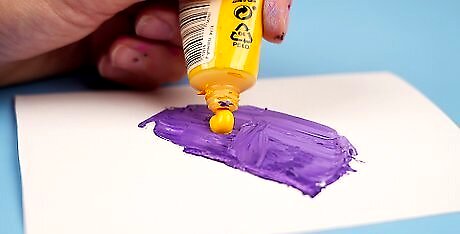
Add in a small amount of cadmium yellow to make a dull, muted purple. To make natural, more earthy colors, artists typically mix complementary colors together. Complementary colors are the colors directly across from each other on the color wheel, which makes purple and yellow complementary colors. With your purple mixture on your mixing palette, add a tiny dot of cadmium yellow and mix it together. This gives you a dull, brownish purple that adds a touch of realism to your painting, or helps your brighter purples pop even more.
Mixing Light and Bright Purples
Add small amounts of purple paint to white paint to make light purple. This is a really simple way to make lovely lavender, amethyst, and pastel purples. Add a large dollop of white paint to your mixing palette. Then, take a tiny amount of the true purple paint you mixed up with your paintbrush or palette knife and mix it with the white paint. It’s best to start out with a super light purple, then slowly add more purple paint to the white paint until you get the pastel hue you want. When you add white to a color, it’s called a tint. Adding white to different purples gives you lots of different pastels. A purple with more red in it gives you a rosy lavender or lilac, while more blue-leaning purple leaves you with a soft periwinkle.
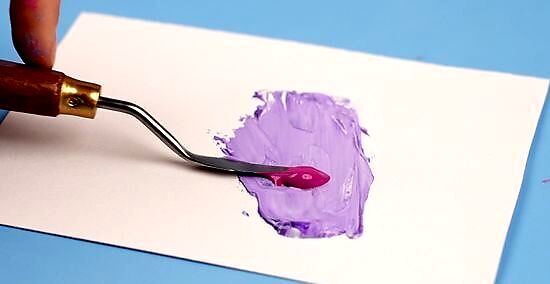
Create a warm violet by adding more permanent rose to your purple mix. After making your batch of true purple, gradually add more permanent rose or quinacridone magenta to create a true violet, plum, jam, or mulberry purple. Just dip the tip of your palette knife or paintbrush into the red paint and mix it with your purple paint. Keep adding bits of red until you have a bright, warm purple.
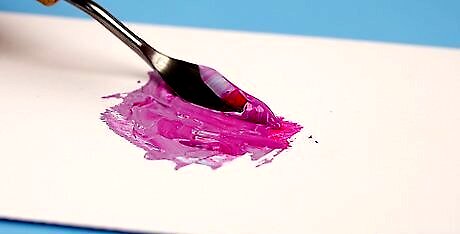
Combine cyan and magenta to make an electric purple. If you’re looking for a bright, shocking purple to add a vivid pop to your paintings, use this purple recipe. Cyan has some green pigment in it which mixes well with the red-purple hue of magenta. Just add 2 to 3 dollops of magenta for 1 dollop of cyan to your mixing palette and swirl them together with your palette knife or paintbrush. If you want a pinker purple, gradually add more magenta to the mixture.
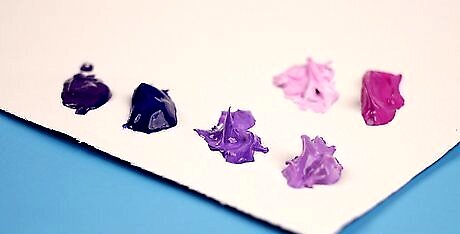
Alter a pre-mixed purple with white to create various tints of purple. If you don’t want to make your own purple paint, use a pre-mixed true purple like dioxazine purple. Just squeeze out some purple and white paint onto your palette. Then, gradually add small amounts of purple paint to the white to make lighter shades like lavender, wisteria, and soft purple. If you want to deepen or darken the purple, just add small dots of ultramarine blue or black to dioxazine purple.




















Comments
0 comment